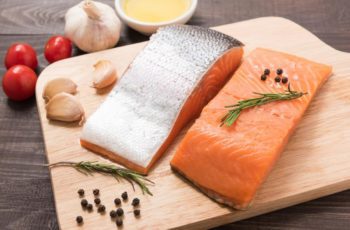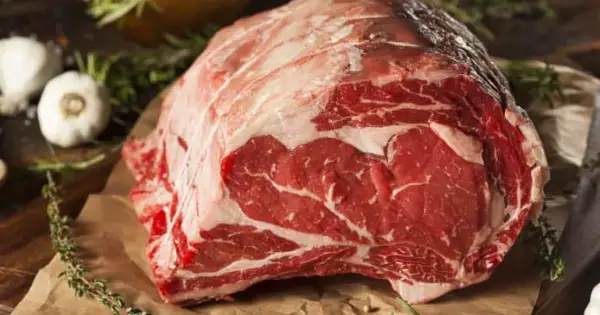
“Indulge in the Juicy Delights of Prime Rib Eye: Discover the exquisite tenderness and rich flavors of prime rib eye, a succulent cut that promises an unparalleled dining experience. From its marbled texture to its mouthwatering taste, savor every bite of this premium steak that will leave you craving for more. Elevate your meal with the superior quality and unmatched juiciness of prime rib eye.”
Prime Rib vs Ribeye: The Difference Explained
Prime rib and ribeye both come from the same beef primal, but they are cooked and prepared differently. A ribeye steak is cooked over high heat, while a prime rib is slow roasted. The size of the cuts also differs, with a ribeye steak being 1-2 inches thick and weighing 8 to 16 oz, while a whole bone-in prime rib can weigh anywhere from 14 to 22 lbs. In terms of taste, there are no significant differences as they come from the same area of the steer, but the flavors may vary depending on how they are cooked/prepared.
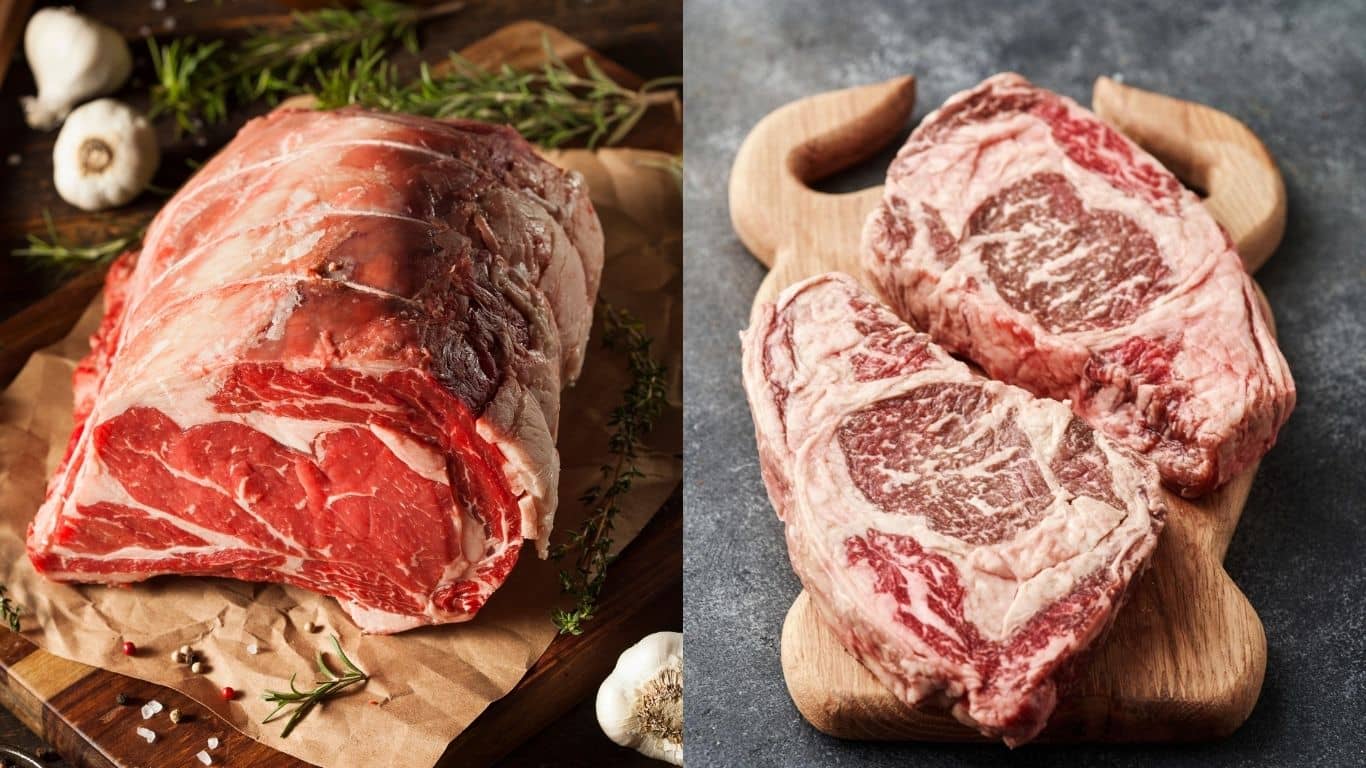
Economically, prime rib is more expensive than buying a single ribeye steak. This is because prime rib comes from the best part of a steer’s rib, which is heavily marbled and has a thick fat cap. A proper prime rib roast can weigh a lot and cost more due to its quality. Butchers often divide the roast into two smaller roasts called first and second cuts to make it more affordable.
The Differences Between Prime Rib and Ribeye
Prime rib and ribeye may come from the same part of the animal, but they are cooked and prepared differently. The main difference lies in their method of cooking. A ribeye steak is cooked over high heat, while a prime rib is slow roasted. This difference in cooking method results in variations in taste and texture.
In terms of size, a ribeye steak is typically 1 – 2 inches thick and weighs between 8 to 16 oz. On the other hand, a whole bone-in prime rib is much larger, being the width of seven ribeye steaks and weighing anywhere from 14 to 22 lbs.
When it comes to taste, there are no significant differences between prime rib and ribeye as they both come from the same area of the steer. However, their flavors can vary depending on how they are prepared. Ribeye steaks are usually salted and peppered before being reverse seared over high heat. Prime ribs often have herbs and spices used to develop a flavorful crust before being slow roasted under low heat.
In terms of cost, a prime rib will generally be more expensive than buying a single ribeye steak due to its larger size and higher demand.
The Anatomy of the Rib Muscle
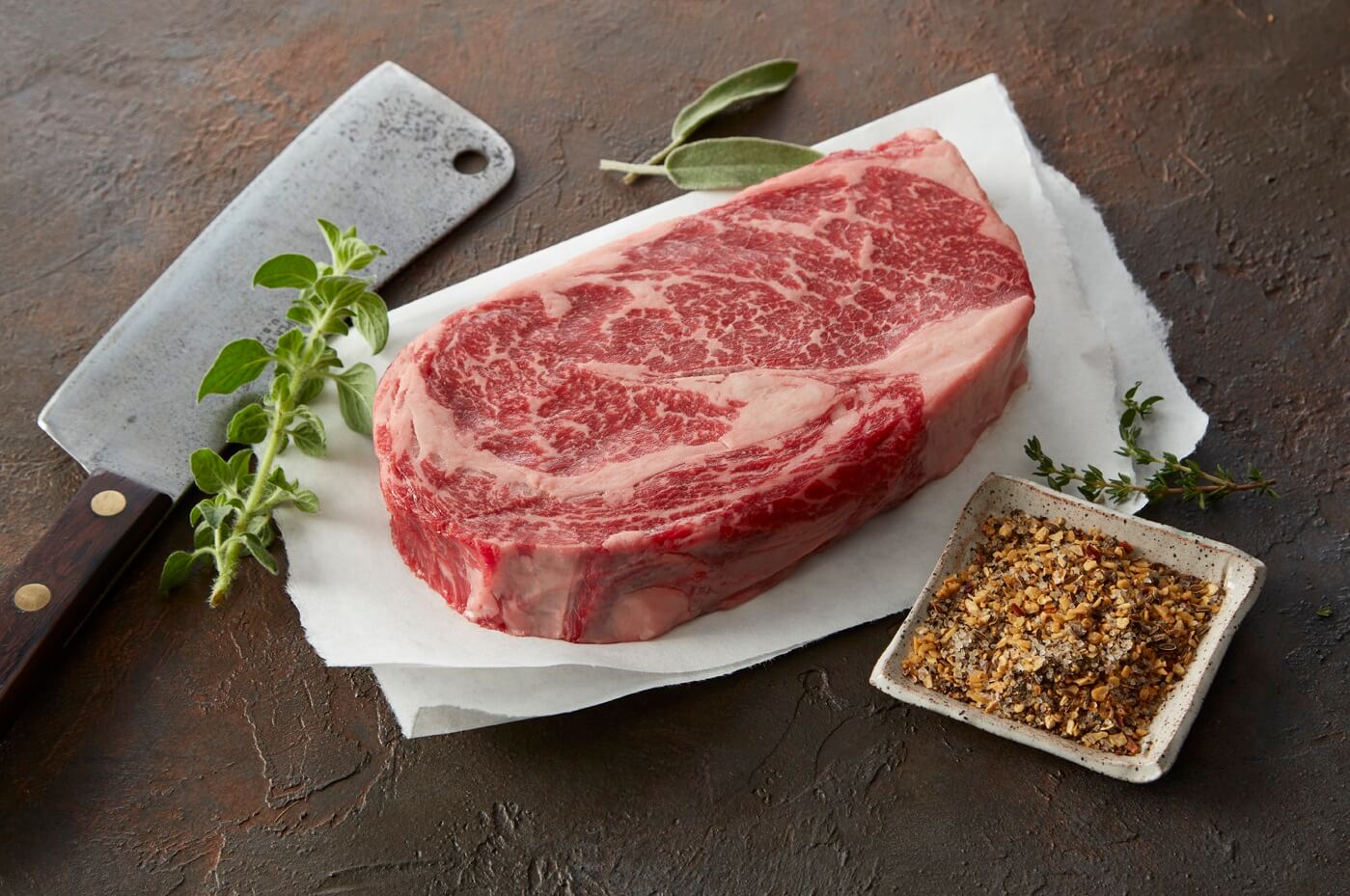
The rib muscle, also known as the ribeye, is located in the rib primal of the steer. It consists of three major muscles: the Longissimus Dorsi, the Spinalis Dorsi, and the Complexus. These muscles are held together by a tender sinew membrane and large swaths of fat. The Longissimus Dorsi, or the eye of ribeye, is the meatiest portion and has the most marbling. Surrounding the eye are two kernels of fat called the Spinalis Dorsi and the Complexus. The Spinalis Dorsi is considered to be the most tender and flavorful part of the steak due to its superior intramuscular fat.
Prime rib and ribeye both come from the same beef primal, but they are cooked differently and have different sizes. A prime rib is slow cooked under low heat, while a ribeye steak is cooked over high heat. In terms of size, a ribeye steak is typically 1-2 inches thick and weighs 8 to 16 oz, while a whole bone-in prime rib can weigh anywhere from 14 to 22 lbs and is about seven times wider than a single ribeye steak.
In terms of taste, there are no significant differences between prime rib and ribeye as they come from the same area of the steer. However, their flavors can vary based on how they are cooked or prepared. A ribeye steak is usually salted and peppered before being reverse seared over high heat. On the other hand, prime ribs often have herbs and spices used to develop a flavorful crust before being slow roasted under low heat. The preparation methods contribute to their distinct textures and flavors.
When it comes to economics, prime rib is generally more expensive than buying a single ribeye steak. This is due to its larger size and the fact that it comes from the best part of the steer’s rib, which has a thick fat cap and heavily marbled meat. A whole prime rib can be divided into two smaller roasts called first and second cuts to make it more affordable for consumers.
Longissimus Dorsi
The Longissimus Dorsi, also known as the eye of ribeye, is the meatiest portion of the ribeye steak. It is located in the center (or eye) of the cut and is surrounded by two kernels of fat called the spinalis dorsi and the complexus. The rib primal, where the Longissimus Dorsi is found, is not heavily exercised and thus collects a lot of intramuscular fat, resulting in marbling throughout this muscle. This marbling contributes to the tenderness and flavor of the meat.
The Spinalis Dorsi, also known as the cap of the ribeye, is another muscle that makes up the ribeye steak. Of the three muscles in a ribeye steak, it has superior intramuscular fat. Many people consider this part to be the most tender and flavorful section of the steak due to its marbling. The Spinalis Dorsi surrounds the Longissimus Dorsi muscle and adds richness to each bite.
The Complexus is the smallest muscle in a ribeye steak and may not even be present depending on which rib it comes from. It is typically found closer to the front end and may only consist of a bite or two. While similar to the Spinalis Dorsi in terms of flavor profile, there is significantly less Complexus in each steak.

Spinalis Dorsi
The Spinalis Dorsi is the cap of the ribeye and is considered to be the most tender and flavorful part of the steak. It has superior intramuscular fat, which adds to its rich taste and texture. This muscle is located on top of the longissimus dorsi, which is the meatiest portion of the ribeye.
The Complexus is the smallest muscle of the ribeye and may not always be present depending on which rib it comes from. It is located next to the spinalis dorsi and has similar characteristics in terms of flavor and tenderness. However, due to its smaller size, you will get significantly less of this muscle in a ribeye steak.
The rib primal refers to a section of the steer’s ribs, specifically ribs 6-12. This area is considered prime for obtaining ribeye steaks because it has a thick fat cap and heavily marbled meat. The marbling provides moisture and flavor to the steak, resulting in a juicy and tender cut of beef.
Complexus
The complexus is the smallest muscle of the ribeye. It may not even be present in certain cuts, depending on which rib it is from (between 6 and 12). For instance, a cut closer to the front will have a small piece of the complexus, usually just a bite or two. The complexus is very similar to the spinalis dorsi, but you get significantly less of it compared to the other muscles.
What is Prime Rib
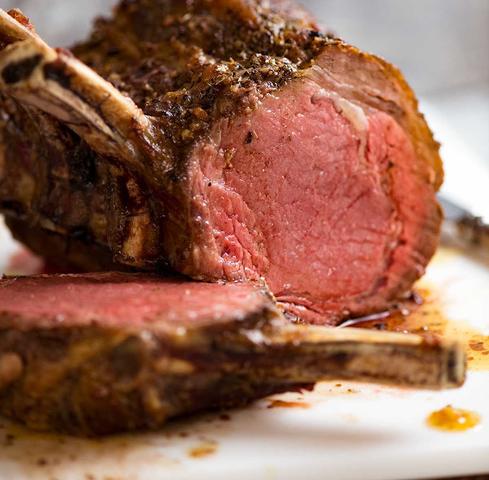
Prime rib, also known as a rib roast or standing rib roast, is a cut of beef that comes from the best part of a steer’s rib. It is typically found in the middle section between rib bones 6 – 12. A whole prime rib can weigh anywhere from 14 to 22 lbs and is considered to be high-quality meat due to its thick fat cap and heavily marbled meat. The name “prime” refers to the location of the meat, not because it is USDA Prime Grade beef.
There are two common methods for cooking prime rib: searing first and then roasting low and slow or roasting at a low temperature until medium-rare. Both methods aim to develop a flavorful outer crust and a red center. Some people prefer to season prime rib with herbs and spices to create an extraordinary crust before slow-roasting it under low heat. Prime rib is known for its tenderness and rich flavor, making it a popular choice for special occasions.
Due to its size and quality, prime rib tends to be more expensive than buying individual ribeye steaks. Butchers often divide the whole prime rib into smaller roasts called first and second cuts, making it more affordable for consumers who don’t need such a large quantity of meat. However, even these smaller cuts can still be quite costly compared to other steak options.
How is Prime Rib Cooked
Prime rib is typically cooked by first searing it over high heat and then slow roasting it at a low temperature. The goal is to develop a flavorful crust on the outside while keeping the center tender and juicy. Some people also like to use herbs and spices to enhance the flavor of the prime rib before slow roasting it.
Ribeye steak can be cut bone-in or boneless, and there are different variations such as cowboy steak and Tomahawk steak. A bone-in ribeye steak is often called a cowboy steak, while a boneless ribeye steak is more commonly known as a traditional ribeye. The Tomahawk steak is a bone-in ribeye with a long frenched bone, resembling a tomahawk axe.
Ribeye steaks are usually cooked by searing them over high heat and then allowing them to come up to the desired internal temperature in the cool zone. Another popular cooking method for ribeye steak is the reverse sear, where the steak is first cooked in a cool zone until it reaches near the desired temperature, and then seared in a hot zone. It’s important not to overcook ribeye steaks in order to maintain their tenderness and juiciness.
What is Rib-eye Steak
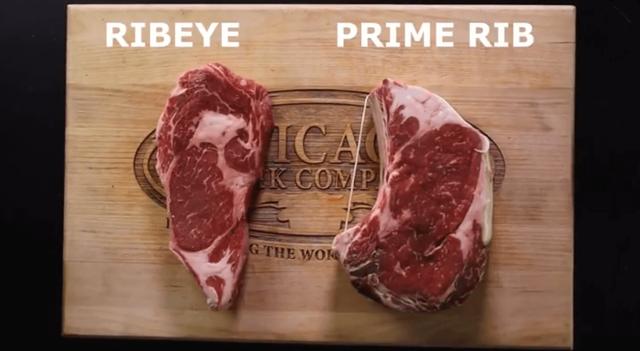
Rib-eye steak is a beef steak that comes from the rib primal or the cylindrical muscle that is close to the steer’s rib. It is a popular cut of steak known for its tenderness and rich flavor. A true rib-eye steak is just the center longissimus dorsi muscle with the other two muscles and fat removed. However, the term “ribeye” is often used as a catch-all term to refer to this type of beef steak.
There are different ways to cut a ribeye steak, but generally, it can be either bone-in or boneless. When the bone is left in, it is commonly called a cowboy steak. When the bone is left long and frenched, it is referred to as a Tomahawk steak. Ribeye steaks are typically cooked over high heat, either by searing first and then finishing in the oven or using a reverse sear method where the steak is cooked slowly at a low temperature and then finished with a quick sear.
How is Ribeye Steak Cooked
Ribeye steak is typically cooked over high heat. The conventional way to cook a ribeye steak is to sear it over high heat and then transfer it to a cooler zone to reach the desired internal temperature. However, some prefer a reverse sear method, where the steak is first placed in a cooler zone and allowed to come up to near the finish temperature before being seared in the hot zone. The steak should be cooked to medium rare, with an internal temperature of around 130 – 135F.
Ribeye steak can be bone-in or boneless. When the bone is left in, it is commonly referred to as a cowboy steak. Another variation is the Tomahawk steak, where the bone is left long and frenched. These different cuts offer variations in presentation and may affect cooking times and techniques.
The main difference between prime rib and ribeye steak lies in their method of cooking. Prime rib is slow-cooked, often with herbs and spices used to develop a flavorful crust, while ribeye steak is cooked over high heat. In terms of size, prime rib is much larger than a single ribeye steak, weighing anywhere from 14 to 22 lbs compared to a typical 8-16 oz ribeye steak. Additionally, prime rib is generally more expensive than buying individual ribeye steaks.
In conclusion, prime rib eye is a highly sought-after cut of beef known for its exceptional tenderness, juiciness, and rich flavor. Whether enjoyed grilled, roasted, or seared to perfection, this premium steak offers a delectable dining experience that satisfies the most discerning palates. Indulge in the succulent goodness of prime rib eye and elevate your culinary journey with every bite.
Learn More About Grilling
If you want to learn more about grilling, check out these other helpful resources!





